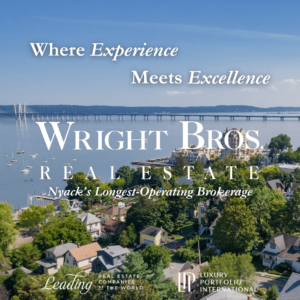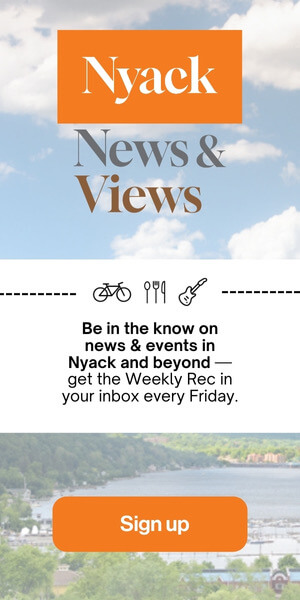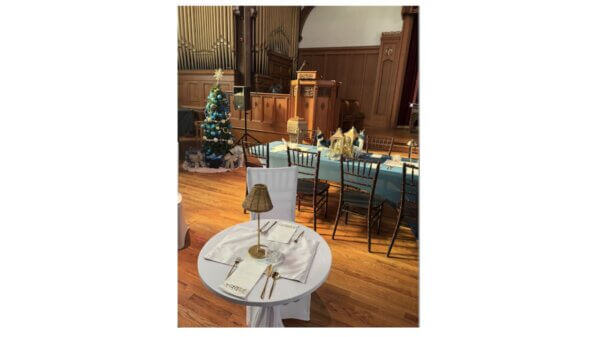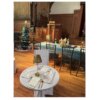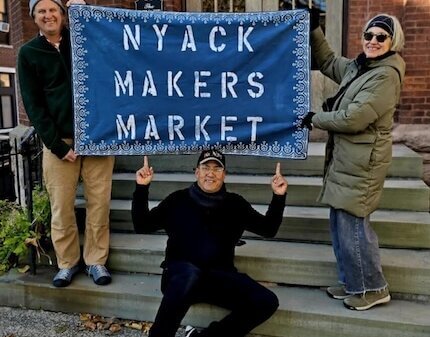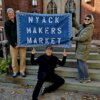Tucked just off South Greenbush Road in West Nyack, Buttermilk Falls County Park is a surprisingly secluded retreat, only minutes from the rush of Route 59 and the New York State Thruway. Named for the frothy white water that tumbles down a 20-foot ledge after heavy rains, this modest cascade is one of 37 “Buttermilk Falls” across New York State.
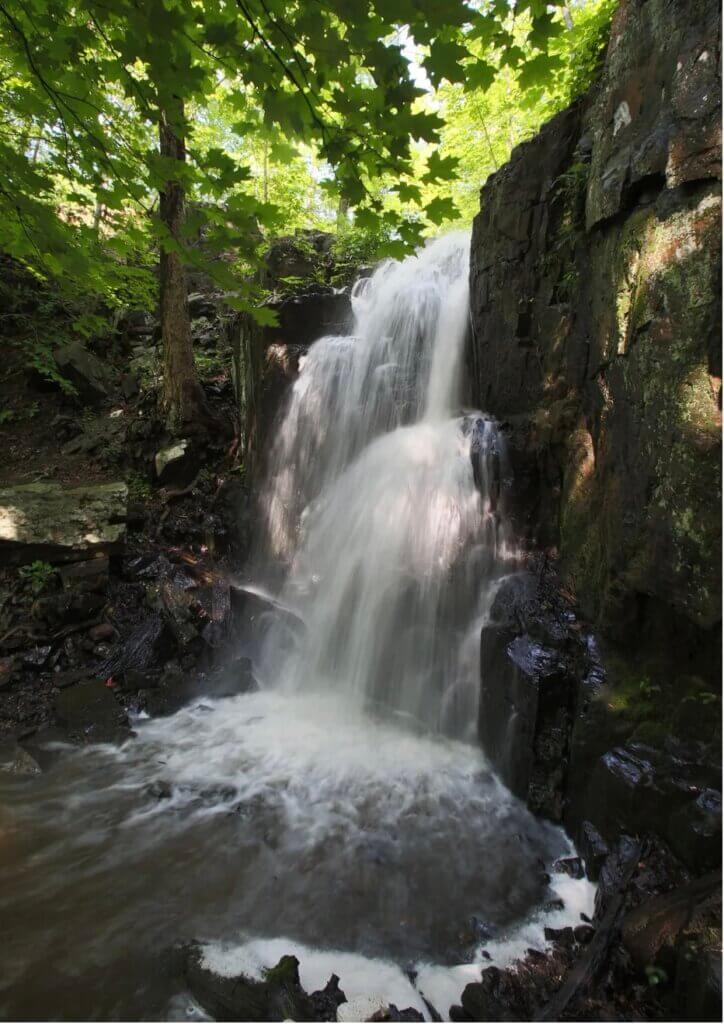
The Dutch once called it Karnmelk Waterval—Buttermilk Waterfall—and some early visitors dubbed it the “Miniature Buttermilk Falls” to distinguish it from its better-known counterparts in Ithaca and elsewhere. But for more than a century, it was the surrounding glen—cool, shaded, and framed by steep rock walls—that made the spot a summer favorite for picnickers, artists, and nature lovers. Known locally as De la Vergne’s Glen, this site reveals a layered history of leisure, local lore, and cultural change in Rockland County.
“Don’t expect Niagara Falls—except after a storm.”
Most summer days, the glen is dry. But its cooling shade and dramatic cliffs have drawn visitors for over a century.
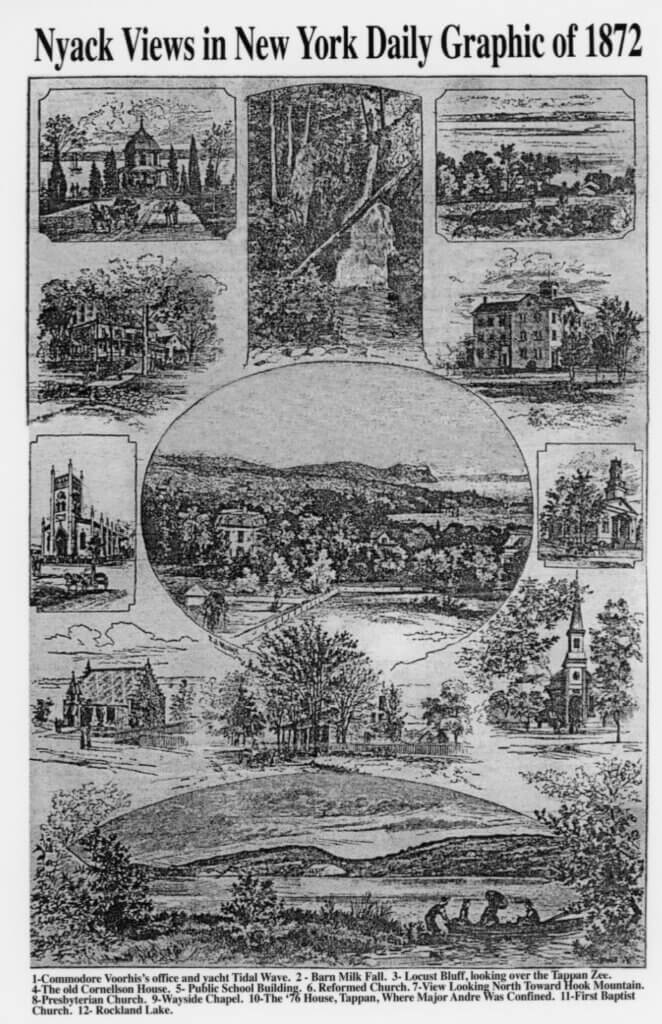
The Glen’s Gilded Age
By the 1870s, locals referred to the area simply as “The Glen.” Its natural beauty attracted summer visitors looking to escape the heat. In the 1880s, the owner of the Tappan Zee House hotel in South Nyack, Charles De la Vergne, began bringing his guests here by carriage, often at sunset. Others arrived by foot or took the West Shore Stage to West Broadway and walked the rest of the way.
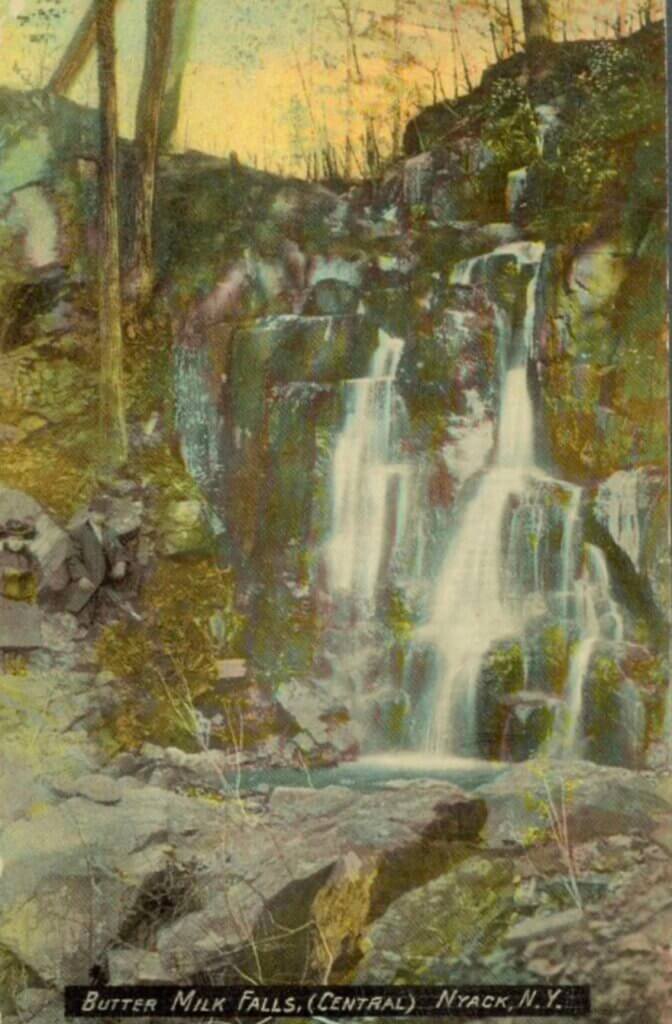
Even when the falls ran dry in summer, the shaded groves and sweeping vistas kept people coming. Even Theodore Roosevelt reputedly favored the view. Artists and photographers made the glen one of the area’s most picturesque destinations.
“They came by carriage for sunsets and scenery.”
In the 1880s, hotel guests from South Nyack were taken to the glen at twilight—its beauty was part of the resort experience.
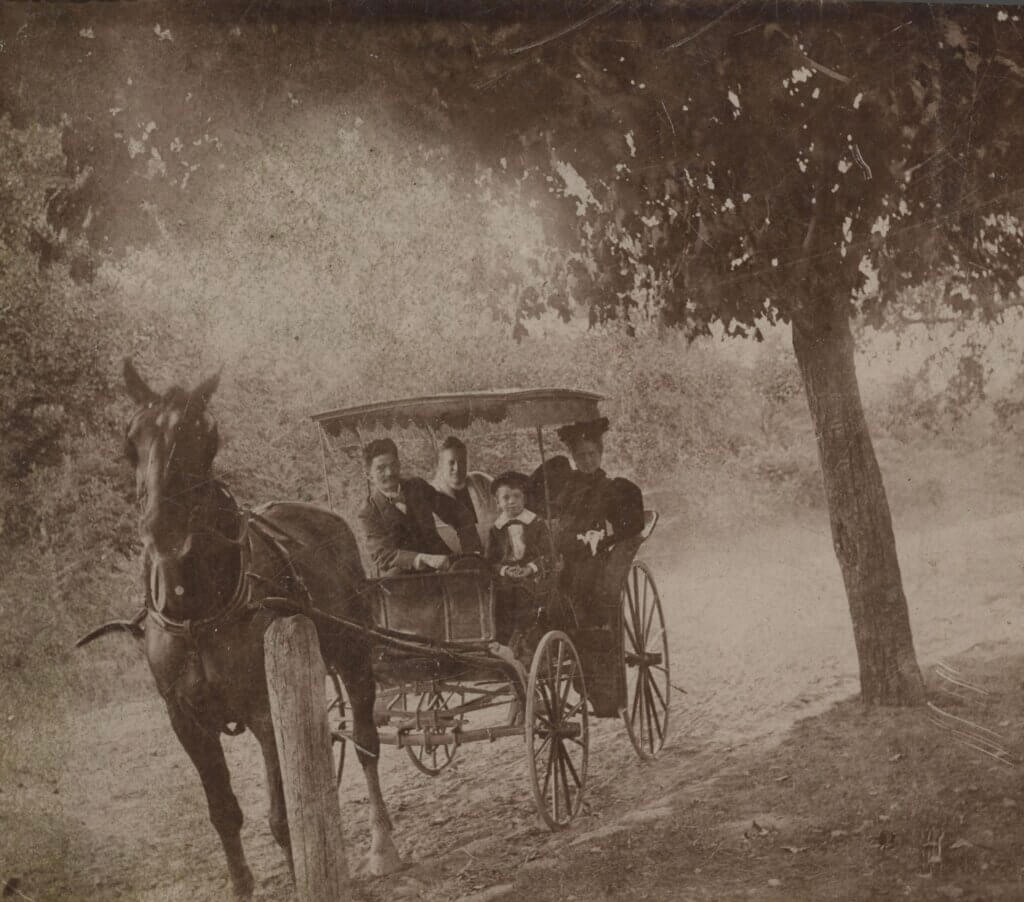
Artistic Renderings During the Gilded Age
The work of two local artists confirms the popularity and significance of Buttermilk Falls during the Gilded Age. In 1863, West Nyack painter William Henry Hill captured the dry falls in A Study of Trap Rock (Buttermilk Falls) –a meticulously detailed oil painting now in the collection of the Metropolitan Museum of Art.
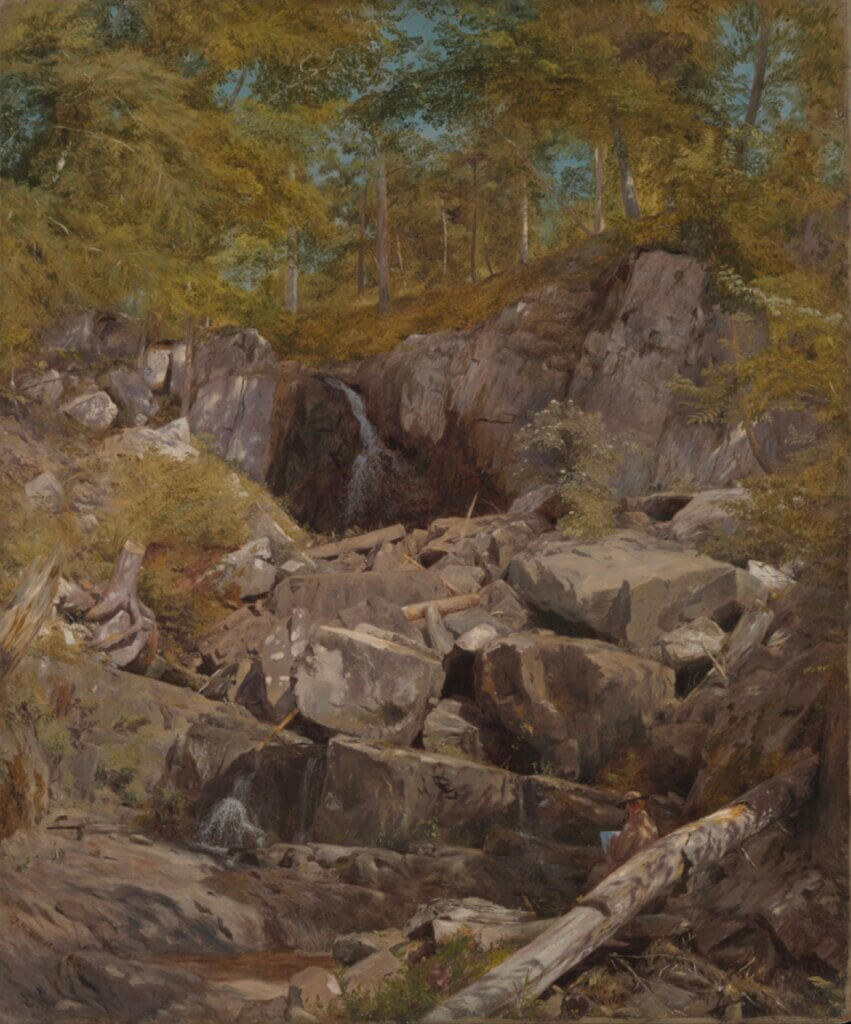
A decade later, Nyack photographer Isaac Van Wagner featured the flowing falls in his stereoscope series Nyack and Vicinity. He highlighted the site’s natural allure by adding people in the frame to show scale. Preserved by the New York Public Library, his images of De la Vergne’s Glen reinforced the glen’s reputation as a local treasure. Though no longer a major artistic subject today, the falls remain a quiet inspiration for those who seek them out.




Three examples of Isaac Van Wagner’s photographs of Buttermilk Falls. All three came from stereoscope prints as shown at the bottom. Notice the person sitting by the tree at the top of the falls. Courtesy of the New York Public Library.
A Summer Park Called Tranquillo
By 1910, a New York City artist purchased the property with ambitious plans, including a pavilion that was never built during his tenure. That summer, the glen hosted picnics for children from the Christian Herald Home and the Central Nyack Congregational Church Sunday School. Visitors played games, watched magic shows, and enjoyed lemonade and ice cream beneath the trees—even if the falls were dry.
“Ten cents bought a shady picnic, a magic show, and ice cream.”
In 1910, children from Central Nyack gathered for a summer outing in the newly named Tranquillo Park—even if the falls weren’t flowing.
The artist named it “Tranquillo Park,” reflecting the quietude that made it a perfect escape. Some visitors entered free; others paid ten cents for the day’s pleasures.
New Ownership, New Purpose
In 1913, Clara Francis Wolverton Gates acquired the land. Improvements under her tenure included access by building a road—likely today’s private Buttermilk Falls Road—off Waldron Avenue. She added picnic tables, a small pavilion, benches, and gardens. The park remained popular with local groups, including the Campfire Girls and students from the Missionary Alliance (later Nyack College).
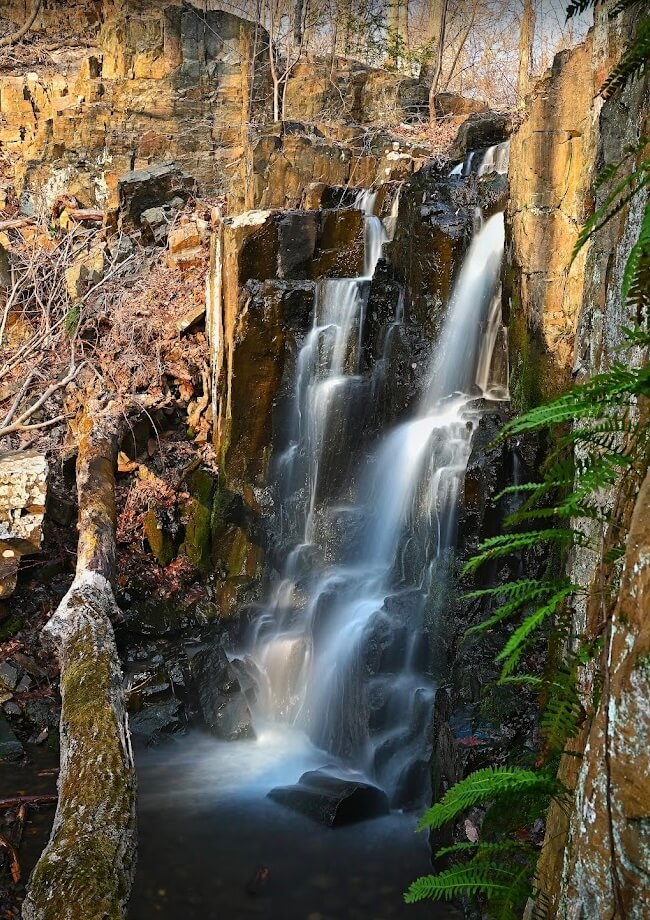
In a sign of growing environmental awareness, Gates hosted a July 4, 1915 seminar titled “Clean Up the Swamp”. She brought together geologists and foresters to discuss the nearby Greenbush Swamp—now the site of the Palisades Center Mall.
Outsiders and Intrusions: Encampments, Nudists, and Snakes
Before World War I, temporary encampments described by local newspapers as “gypsy camps” (a now outdated and inaccurate term for Romani or itinerant groups) occasionally appeared near the junction of Route 59 and Greenbush Road. These groups traded horses and told fortunes, drawing both curiosity and complaints from residents. Today, “Gypsy Camp Road,” a small dead-end off Ward Drive, is a lingering reminder of this little-known history.
“From fortune-tellers to copperheads, the glen has seen it all.”
The glen’s quiet past includes Romani encampments, nudist colony proposals, and its fair share of local wildlife.
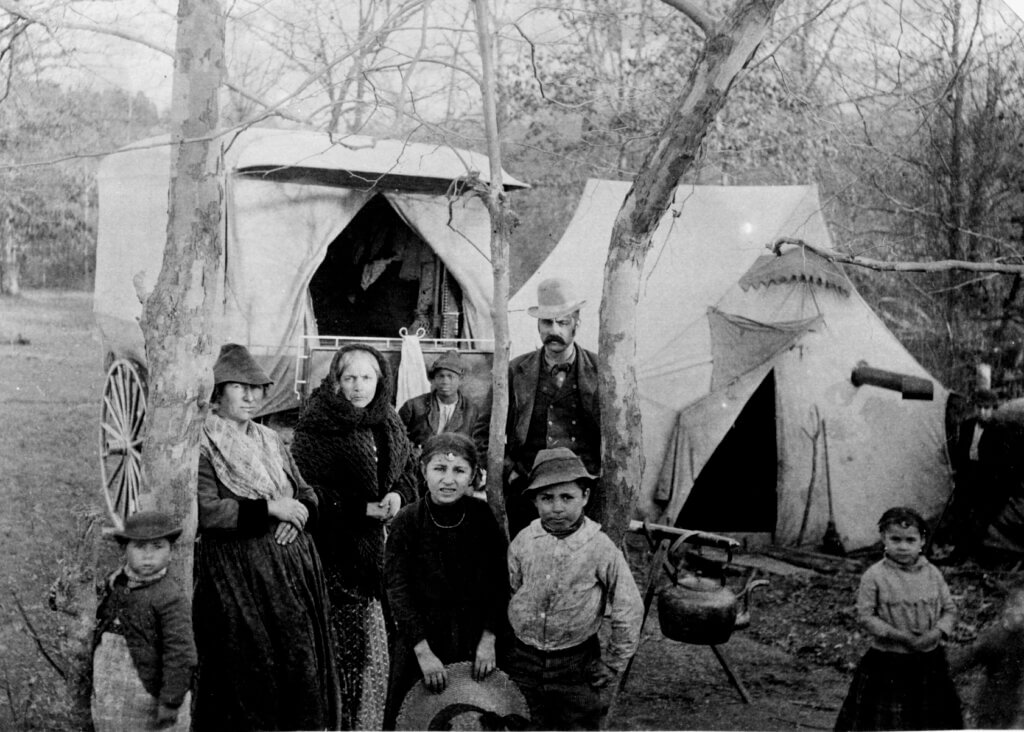
In 1935, Buttermilk Falls made headlines when a Black nudist group from Harlem applied for a license to establish a camp nearby. Outrage followed, and within days, the New York State Senate passed a law banning nudist camps in New York, led by former Governor Al Smith and the Legion of Decency.
Adding to the location’s colorful past, the hillside once known as Snake Hill was home to copperhead snakes—venomous but shy. Though rarely seen today, the species still inhabits the rocky outcrops and forested slopes of the Palisades. Hikers are advised to tread carefully.
From Private Retreat to County Park
Efforts to preserve Buttermilk Falls as public land began in 1967, when Martin Bernstein proposed the idea to the Clarkstown Town Board. Though the property extended into Orangetown and early plans fell through, preservation efforts gained new urgency in the 1970s as developers proposed nearby apartment complexes.
“A 10-year fight saved the falls from development.”
Plans for apartments in the 1970s spurred residents and county leaders to preserve 72 acres as a public park.
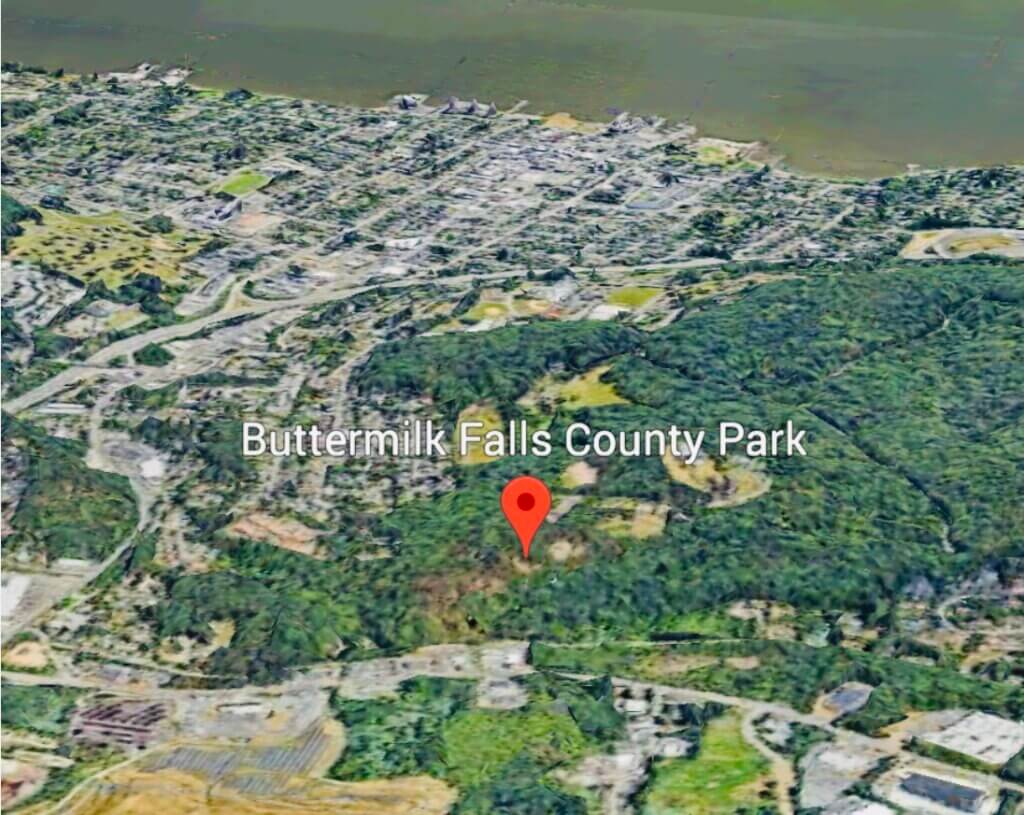
The 72-unit Vista complex was completed in 1972 just above Greenbush Road, prompting further debate over land rights and public access. Eventually, with help from federal funding, Rockland County acquired 72 acres—about half of the original proposal. In 1977, Buttermilk Falls County Park officially opened.
Soon after, naturalists like Carol Weiss from the Rockland Audubon Society led bird walks and flower tours. Trails were added and linked to neighboring parks, forming a valuable greenbelt in a rapidly suburbanizing region.
Planning Your Visit
“What once took a carriage ride now takes ten minutes by car.”
A hike at Buttermilk Falls reconnects us to a time when escaping summer heat meant following a stream into the woods.
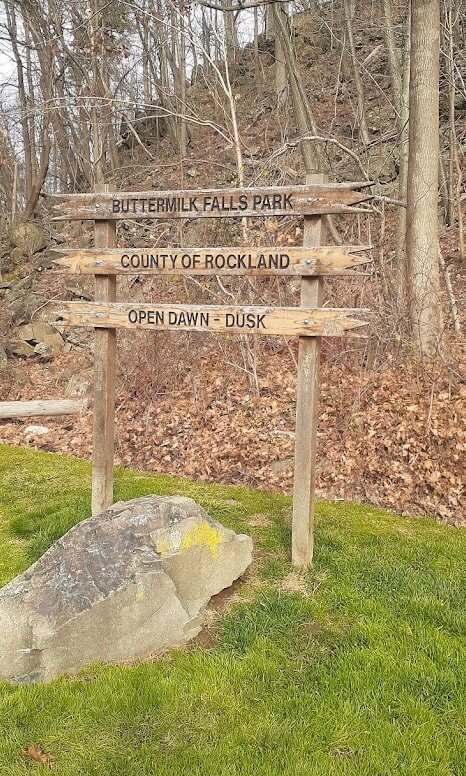
Buttermilk Falls County Park is still a perfect spot for a summer hike, picnic, or quiet moment in nature. Though the falls are often dry in summer, the shady glen and scenic overlooks remain timeless. As you walk the trails, imagine the 19th-century villagers who came here by carriage, seeking cool breezes and views of the Ramapo Mountains.
Hiking in & Around Buttermilk Falls
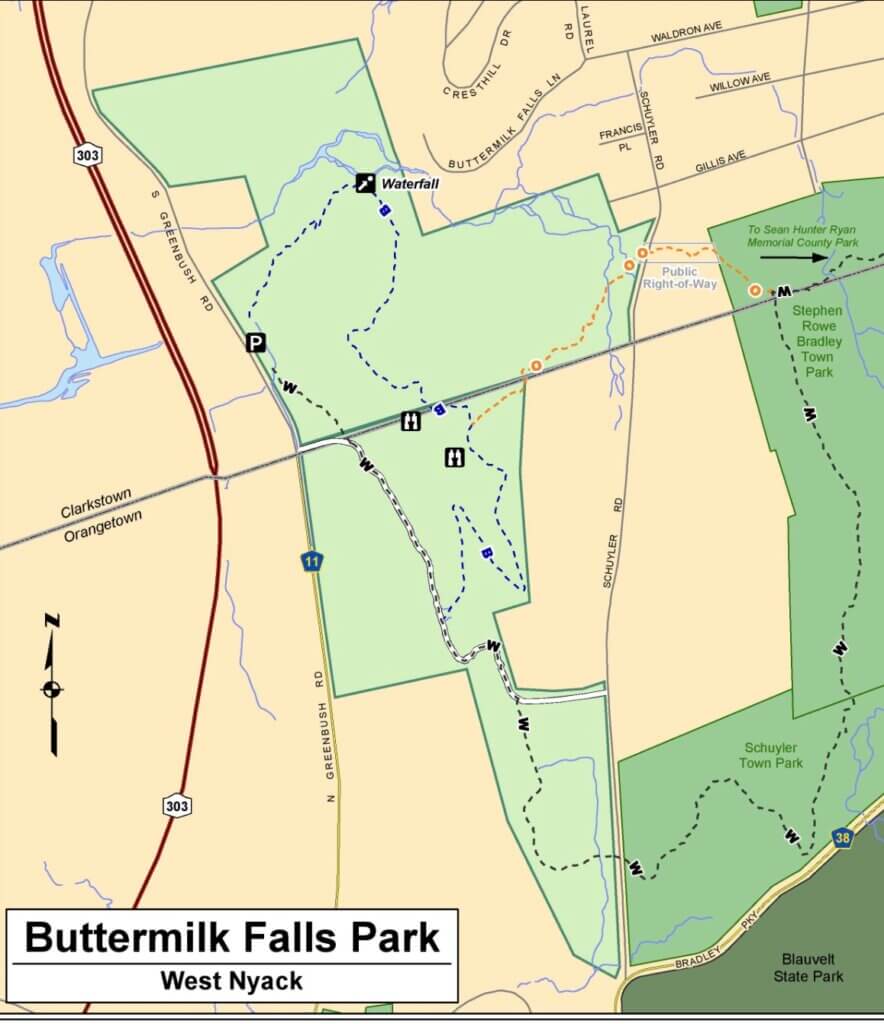
From the Buttermilk Falls Parking Lot (South Greenbush Road)
From the parking lot, you’ll find two entrances to the blue-blazed loop trail (about 1 mile total). The northern entrance (on your left) climbs steeply along a rocky path, passing a viewpoint above the falls and continuing to scenic overlooks with westward views toward the Ramapo Mountains. On windy days, you may hear distant Thruway traffic from the valley below.
The return portion of the loop is a gentler descent along an old wood road. Since the trail is circular, hikers may begin in either direction.
To extend your hike, take the orange-blazed trail near the lookouts. It leads north across Schuler Road into Stephen Rowe Bradley Park. At the white-blazed T-intersection, turn right to rejoin the blue trail, then left to return to the parking lot. This loop is about 2.1 miles. Longer hikes can continue into Blauvelt State Park.
From the Rockland Center for the Arts (RoCA)
Park at RoCA and stroll through the Katherine Konner Sculpture Park. The short yellow-blazed loop winds among artworks in a meadow setting. From the southern end of the trail (turning right from the building), a red-blazed spur leads to a viewpoint across the glen with a partial view of the falls.
The deep glen itself is overgrown and not easily accessible. Fallen trees and steep slopes make bushwhacking difficult, and it’s hard to picture the open picnic grounds that once drew hundreds.
Mike Hays lived in the Nyacks for 38-years. He worked for McGraw-Hill Education in New York City for many years. Hays serves as President of the Historical Society of the Nyacks, Vice-President of the Edward Hopper House Museum & Study Center, and Upper Nyack Historian. Married to Bernie Richey, he enjoys cycling and winters in Florida. He has written the Nyack People & Places column since 2017. You can follow him on Instagram as UpperNyackMike.
Editor’s note: This article is sponsored by Sun River Health and Ellis Sotheby’s International Realty. Sun River Health is a network of 43 Federally Qualified Health Centers (FQHCs) providing primary, dental, pediatric, OB-GYN, and behavioral health care to over 245,000 patients annually. Ellis Sotheby’s International Realty is the lower Hudson Valley’s Leader in Luxury. Located in the charming Hudson River village of Nyack, approximately 22 miles from New York City. Our agents are passionate about listing and selling extraordinary properties in the Lower Hudson Valley, including Rockland and Orange Counties, New York.


